How to clean your computer and its components
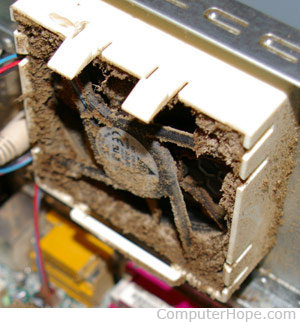
Taking good care of your computer is important. Cleaning your computer, components, and peripherals helps keep everything in good working condition, helps prevent germs from spreading, and helps allow proper airflow. The picture shows an example of how dirty the inside of your computer case can get. Looking at this picture, it's immediately obvious that all the dust and dirt prevents proper airflow and may even prevent the fan from working.
How often should I clean my computer?
The frequency of how often to clean your computer varies on different factors. To help determine how often to clean your computer, we created the checklist below. Check each box below that applies to your computer's conditions to help determine how often to clean the computer.
General cleaning tips
Below are suggestions for cleaning any computer components or peripherals and tips to help keep a computer clean.
- Never spray or squirt any liquid onto any computer component. If a spray is needed, spray the liquid onto a cloth.
- Use a vacuum to suck up dirt, dust, or hair around the computer. However, do not use a vacuum inside your computer as it generates static electricity that damages your computer. If you need to vacuum inside your computer, use a portable battery-powered vacuum or try compressed air.
- When cleaning a component or the computer, turn it off before cleaning.
- Be cautious when using any cleaning solvents; some people have allergic reactions to chemicals in cleaning solvents, and some solvents can even damage the case. Try always to use water or a highly diluted solvent.
- When cleaning, be careful not to adjust any knobs or controls accidentally. Also, when cleaning the back of the computer, if anything is connected make it's not accidentally disconnected.
- When cleaning fans, especially smaller ones, hold the fan or place something between the fan blades to prevent it from spinning. Spraying compressed air into a fan or cleaning a fan with a vacuum may cause damage or generate a back voltage.
- Never eat or drink around the computer.
- Limit smoking around the computer.
Cleaning tools
Although computer cleaning products are available, many household items are suitable for cleaning your computer and its peripherals. Below are items you may need or want to use while cleaning your computer.
- Cloth - A cotton cloth is the best tool for rubbing down computer components. Paper towels can be used with most hardware, but we always recommend using a cloth whenever possible. However, only use a cloth when cleaning components such as the case, a drive, a mouse, and a keyboard. Don't use a cloth to clean any PCB (printed circuit board), such as the RAM (random-access memory) or motherboard.
- Water or rubbing alcohol - When moistening a cloth, it is best to use water or rubbing alcohol. Other solvents may be bad for the plastics used with your computer.
- Portable Vacuum - Sucking the dust, dirt, hair, cigarette particles, and other particles out of a computer can be one of the best methods of cleaning a computer. However, do not use a vacuum that plugs into the wall since it creates static electricity that damages your computer.
- Cotton swabs - Cotton swaps moistened with rubbing alcohol or water are excellent tools for wiping hard-to-reach areas on your keyboard, mouse, and other locations.
- Foam swabs - Whenever possible, it is better to use lint-free swabs such as foam swabs.
See our computer tools page for a list of other tools every technician should have.
Case cleaning
Why? Cleaning your case keeps the computer looking new. While cleaning, if you see ventilation slots, these can be cleaned or cleared to help keep a steady airflow into the computer and keep all components cool.
Procedure: The plastic case that houses the PC components can be cleaned with a slightly damp, lint-free cloth. For stubborn stains, add a little household detergent to the cloth. Don't use a solvent cleaner on plastics.
Make sure all vents and air holes are hair and lint-free by rubbing a cloth over the holes and vents. It is also helpful to take a vacuum around each of the holes, vents, and crevices on the computer. It is safe to use a standard vacuum when cleaning the outside vents of a computer.
If you are looking for steps on cleaning the inside of the computer, see the motherboard cleaning section.
CD-ROM, DVD, and other disc drive cleaning
Why? A dirty CD-ROM drive or other disc drives can cause read errors when reading discs. These read errors could cause software installation issues or issues while running the program.
Procedure: To clean the CD-ROM (Compact Disc Read-Only Memory) drive, we recommend purchasing a CD-ROM cleaner from your local computer retailer. A CD-ROM cleaner should sufficiently clean the laser from dust, dirt, and hair.
Use a cloth dampened with water to clean the tray that ejects from the drive. However, ensure the tray is dry after cleaning before pushing it back into the drive.
See the disc cleaning recommendation for further steps on cleaning each of your CDs.
CD, DVD, and other disc cleaning
Why? Dirty CDs can cause read errors or cause CDs not to work at all.
Procedure: Use a cleaning kit or damp clean cotton cloth to clean a CD, DVD (digital versatile disc), and other disc. When cleaning a disc, wipe against the tracks, starting from the middle of the disc and wiping towards the outer side. Never wipe with the tracks; doing so may put more scratches on the disc.
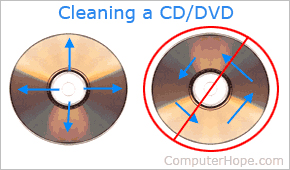
If the substance on a CD cannot be removed using water, pure alcohol can also be used.
Hard drive cleaning
Why? Computer hard drives cannot be physically cleaned. However, it can be cleaned with software utilities to help it run fast and efficiently. Utilizing these utilities prevents the hard drive from slowing down.
Procedure: See our basic troubleshooting section for your operating system steps to help improve the computer's performance.
Headphones cleaning
Why? Many people may use the same headphones and headsets, which may need to be frequently cleaned to help prevent germs and head lice spreading.
Procedure: If the headphones are plastic or vinyl, moisten a cloth with warm water and rub the head and earpieces of the headphones.
Library or school headphones should not be cleaned with any disinfectant or cleaning solvent since some people can react to the chemicals they contain.
Headphones that have cushions also have the availability of having the cushions replaced. Replacing these cushions can also help keep the headphones clean.
Finally, as far as headphones spreading head lice. If different students use the same headphones, have headphones for each student, place bags over the headphones, or use headphones that can be wiped with warm water after each use.
Keyboard cleaning
These steps are for cleaning a desktop keyboard. For laptops, see: How to clean a laptop.
Dust, dirt, and bacteria
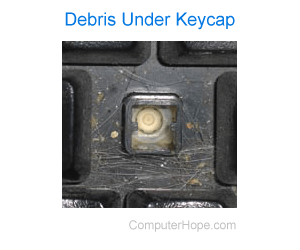
The computer keyboard is usually the most germ-infected item in your home or office. A keyboard may even contain more bacteria than your toilet seat. Cleaning helps remove dangerous bacteria, fix or prevent stuck keys, and keep the keyboard working properly.
Procedure: Before cleaning the keyboard, turn off the computer or unplug it from the computer if you are using a USB keyboard. Not unplugging the keyboard can cause other computer problems, as you may press keys that cause the computer to perform a task you do not want.
Many people clean the keyboard by turning it upside down and shaking it. A more efficient method is to use compressed air. Compressed air is pressurized air in a can with a very long nozzle. To clean a keyboard using compressed air, aim between the keys and blow away all the dust and debris. A vacuum cleaner can also be used, but make sure the keyboard does not have a loose "pop off" key the vacuum can suck up.
To clean the keyboard more extensively, remove the keys from the keyboard.
After the dust, dirt, and hair are removed. Spray a disinfectant onto a cloth or use disinfectant cloths and rub each key on the keyboard. Never spray any liquid onto the keyboard.
Substance spilled into the keyboard
If the keyboard has anything spilled on it (e.g., pop, cola, Pepsi, Coke, beer, wine, coffee, and milk), not taking the proper steps can destroy the keyboard.
Procedure: Below are recommendations that help prevent a keyboard from becoming bad after something has spilled into the keys.
If anything is spilled onto the keyboard, turn the computer off immediately or, at the very least, disconnect the keyboard from the computer. Once done, flip the keyboard over to prevent the substance from penetrating circuits. While the keyboard is upside down, shake the keyboard over a surface that can be cleaned later. While still upside down, use a cloth to start cleaning the keys. After cleaning the keyboard, leave it upside down for at least two days, allowing it to fully dry. Once dry, continue cleaning the keyboard with any remaining substance.
If the keyboard keys are sticking after cleaning, remove the keys and clean below the keys and the bottom portion of the key.
Finally, if the keyboard still works but remains dirty or sticky, before discarding the keyboard, as a last resort, try washing the keyboard in the dishwasher.
If the keyboard still does not work after doing all the above steps, we recommend buying a new keyboard.
LCD/LED cleaning
Why? Dirt, dust, and fingerprints can cause the computer screen to be difficult to read.
Procedure: Unlike a CRT (cathode ray tube) computer monitor, the LCD (liquid crystal display) or LED (light-emitting diode) monitor is not glass and requires special cleaning procedures.
When cleaning the LCD or LED screen, it's important to remember not to spray any liquids onto the screen directly. Press gently while cleaning, and do not use a paper towel since it can scratch the screen.
To clean the LCD or LED screen, use a non-rugged microfiber cloth, soft cotton cloth, or Swiffer duster. If a dry cloth does not completely clean the screen, apply rubbing alcohol to the cloth and wipe the screen with a damp cloth. Rubbing alcohol is used to clean LCD and LED monitors before it leaves the factory.
CRT monitor cleaning
This section is for CRT computer monitors. See the LCD/LED cleaning section if you have a flat-screen display.
Why? Dirt, dust, and fingerprints can cause the computer screen to be difficult to read.
Procedure: A glass monitor screen can be cleaned with ordinary household glass cleaner. Unplug the monitor power cord and spray the cleaner onto a lint-free cloth to prevent fluid from leaking into any components inside the monitor. Vacuum off any dust that settled on top of the monitor and make sure no books or papers are covering the air vents. Obstructed monitor vents can cause the monitor to overheat or even catch on fire.
We suggest only using a cloth dampened with water when cleaning non-glass monitors or anti-glare screens. Using ordinary household glass cleaners on special screens, especially cleaners with ammonia can remove anti-glare protection or other special surfaces.
Other good cleaning solutions
- Microfiber Towels
- Swiffer Dusters
Related information
Motherboard cleaning
Why? Dust and especially particles of cigarette smoke can build up and corrode circuitry, causing various problems such as computer lockups.
When inside the computer, take the necessary ESD precautions and avoid unplugging any cables or other connections.
Procedure: When cleaning the motherboard from dust, dirt, or hair, we recommend using compressed air. When using compressed air, hold it upright to prevent any chemicals from coming out of the container, which may damage the motherboard or other components. Also, when using compressed air, always blow the dust or dirt away from the motherboard or out of the case.
Another good alternative to compressed air is a portable battery-powered vacuum. Portable vacuums can remove dust, dirt, and hair from the motherboard completely and prevent it from getting trapped in the case.
Never use an electrically powered vacuum, as it can cause static electricity that damages the computer. When using a battery-powered vacuum, keep it a few inches away from components to prevent damage and anything from being sucked into the vacuum (e.g., jumpers).
When cleaning the case's inside, also look at any fans or heat sinks. Dust, dirt, and hair can collect around these components the most.
Mouse cleaning
Optical or laser mouse
Why? A dirty optical or laser mouse can cause the mouse cursor to be difficult to move or move erratically.
Procedure: Use a can of compressed air designed for use with electronic equipment, spraying around the optical sensor on the bottom of the mouse. Blowing air on the bottom of the mouse clears away any dirt, dust, hair, or other obstructions blocking the optical sensor.
Avoid using any cleaning chemicals or wiping a cloth directly on the optical sensor, as it could scratch or damage the optical sensor.
Optical-mechanical mouse (ball mouse)
Why? A dirty optical-mechanical mouse (mouse with a ball) can cause the mouse to be difficult to move and cause strange mouse movement.

Procedure: To clean the rollers of an optical-mechanical mouse, you must first remove the bottom cover of the mouse. To do this, examine the bottom of the mouse to see what direction to rotate the cover. The illustration shows the mouse cover must be moved counterclockwise. Place two fingers on the mouse cover, push down, and rotate in the direction of the arrows.
Once the cover has rotated about an inch, rotate the mouse into its normal position, covering the bottom of the mouse with one hand. The bottom should then fall off, including the mouse ball. If the cover does not fall off, try shaking the mouse gently.
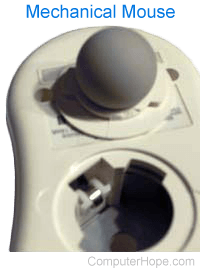
Once the bottom cover and the ball are removed, three rollers should be visible inside the mouse. Use a cotton swab, finger, or fingernail to remove any substances on the rollers. Usually, a small line of hair and dirt is in the middle of the roller. Remove as much of this substance as possible.
Once you have removed as much dirt and hair as possible, set the ball back in the mouse and place the cover back on.
If the mouse still has the same problems, repeat the above process. If, after several attempts the mouse is still having the same problems, your mouse has other hardware issues and should be replaced.
Cleaning your mouse pad with a damp cloth can also help improve a computer's mouse movement.
All types of mice
Why? To help keep the mouse clean and germ-free.
Procedure: Use a cloth moistened with rubbing alcohol or warm water and rub the surface of the mouse and each of its buttons.
Printer cleaning
Why? Cleaning the outside of a printer helps keep the printer's appearance looking good, and if used by many different people, keeps the printer clean of germs.
Procedure: First, ensure the printer is off before cleaning it. Dampen a cloth with water or rubbing alcohol and wipe the case and each of the buttons or knobs on the printer. Never spray any liquid directly onto the printer.
Why? Some printers require the inside to be cleaned to help keep the printer running smoothly.
If the printer produces poor-quality print jobs, it may also need to have its printheads cleaned using the printer self-cleaning.
Scanner cleaning
Why? Flatbed scanners commonly become dirty with dust, fingerprints, and hair. When the scanner is dirty, the images may have distortions.
Procedure: Clean a flatbed scanner's surface by spraying a window cleaner onto a paper towel or cotton cloth and wipe the glass until clean. As mentioned earlier, never spray a liquid directly onto the component.
The same towel or cotton cloth can also be used to clean the outside of the scanner.
Miscellaneous cleaning steps
Below are miscellaneous computer hardware that's rarely used today but kept on this page for people working on older computers.
Floppy drive cleaning
Why? Dirty read/write heads on the floppy drive can cause errors during the reading or writing process.
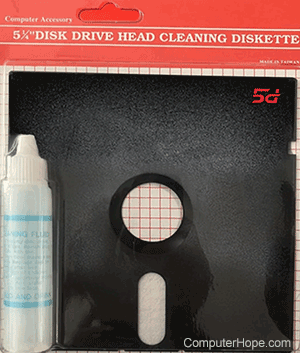
Procedures: The floppy drive is cleaned in different ways. The first method of cleaning a floppy drive is to purchase a kit at your local retail store designed to clean the read/write heads on your floppy drive. The picture shows an example of a 5.25" floppy diskette head cleaning kit.
The second method of cleaning the floppy drive is only recommended for experienced computer users. Open the floppy drive casing and physically swab the read/write heads with a lint-free foam swab soaked in pure alcohol or trichloroethane. When performing these steps, be extremely careful when cleaning the heads to ensure that you do not lock them out of alignment, causing the floppy drive not to work. To help prevent head alignment issues, use a dabbing motion lightly, putting the swab on the head and removing it. Don't perform a side-to-side motion with the swab.
Palm pilot cleaning
Why? Dirty touch screens can cause difficult navigation.
Procedure: To clean the PalmPilot screen, use a soft cloth moistened with rubbing alcohol and rub the screen and casing. It's not recommended to use glass cleaner as it could damage plastics over time.
SuperDisk and LS-120 cleaning
Why? Cleaning the SuperDisk and LS-120 prevents the drive heads from becoming dirty.
Procedure: Purchase the SuperDisk cleaning kit available through Imation. Using any other method voids the warranty on your drive.
